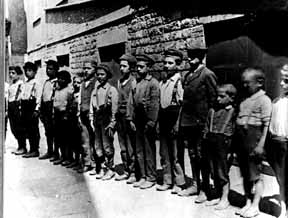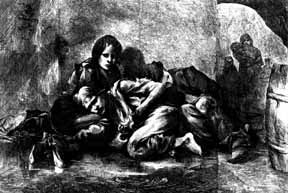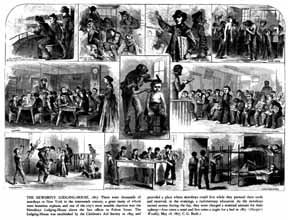| |
|
1861-1916
Juvenile
Delinquency: A Rising Concern
|

Children of the Street "Drilling
the Gang" on Mulberry Street.
(Photo by Jacob Riis)
|
|
During
the period after the Civil War the population grew
and the problems of juvenile reform became larger
and more dynamic. Immigrants from Italy and Eastern
Europe, who followed their Irish and German predecessors,
increasingly dominated New York's cultural landscape.
These immigrants worked longer hours and lived in
increasingly improverished conditions as the century
progressed. In an effort to escape their cramped quarters,
tenement dwellers socialized on the streets, a practice
that exposed children to the dangers of criminal activity
in the community. Whether or not children encountered
trouble, they were more visible on New York City's
landscape then ever before.
|

SCHOOL OR JAIL? reflects the reformist approach to
the problems of juveniles, lack of adequate schooling
would lead to a life of crime.
|
|
In 1865
the New York State Legislature enacted a bill to control
the "disorderly child," (a term roughly
synonymous with today's label, "person in need
of supervision"). The Act provided that, following
the complaint of a parent or guardian, a magistrate
or justice of the peace could "issue a warrant
for the apprehension of the youthful offender."
If a child was found to be disorderly, the court was
required to commit the child to the House of Refuge.
|
 The
NEWSBOYS' LODGING HOUSE, 1867. There were thousands
of newsboys in New York in the 19th century, a great
many of whom were homeless orphans. The Lodging House
was located above the Sun offices on Fulton Street,
established by the Children's Aid Society in 1854.
The
NEWSBOYS' LODGING HOUSE, 1867. There were thousands
of newsboys in New York in the 19th century, a great
many of whom were homeless orphans. The Lodging House
was located above the Sun offices on Fulton Street,
established by the Children's Aid Society in 1854.
(Harper's
Weekly; May 18,1867;C.G. Bush).
|
| Though
the Disorderly Child Act hinged on parental complaint,
it represented a move away from parental authority.
Under the Act, a child did not need to have committed
a crime - "disorderly" conduct was sufficient
justification for placement. Additional measures designed
to reform child behavior soon followed.
In 1875
the Society for the Prevention of Cruelty to Children
was formed to protect the rights of children. Along
with similar groups, the Society campaigned for a
series of legal reforms in the 1870's and 80's that
resulted in a child neglect statute, the Parens Patriae
Doctrine (which granted the state the state the inherent
right to assume custody of children), and a codified
assemblage of children's laws. These efforts culminated
in the creation of a separate children's court system
in 1892, which allowed for all cases involving the
commitment or trial of children, to be heard and determined
by a court devoted to juvenile cases.
|
| <
1800-1861 |
1916-1957
> |
|
|
